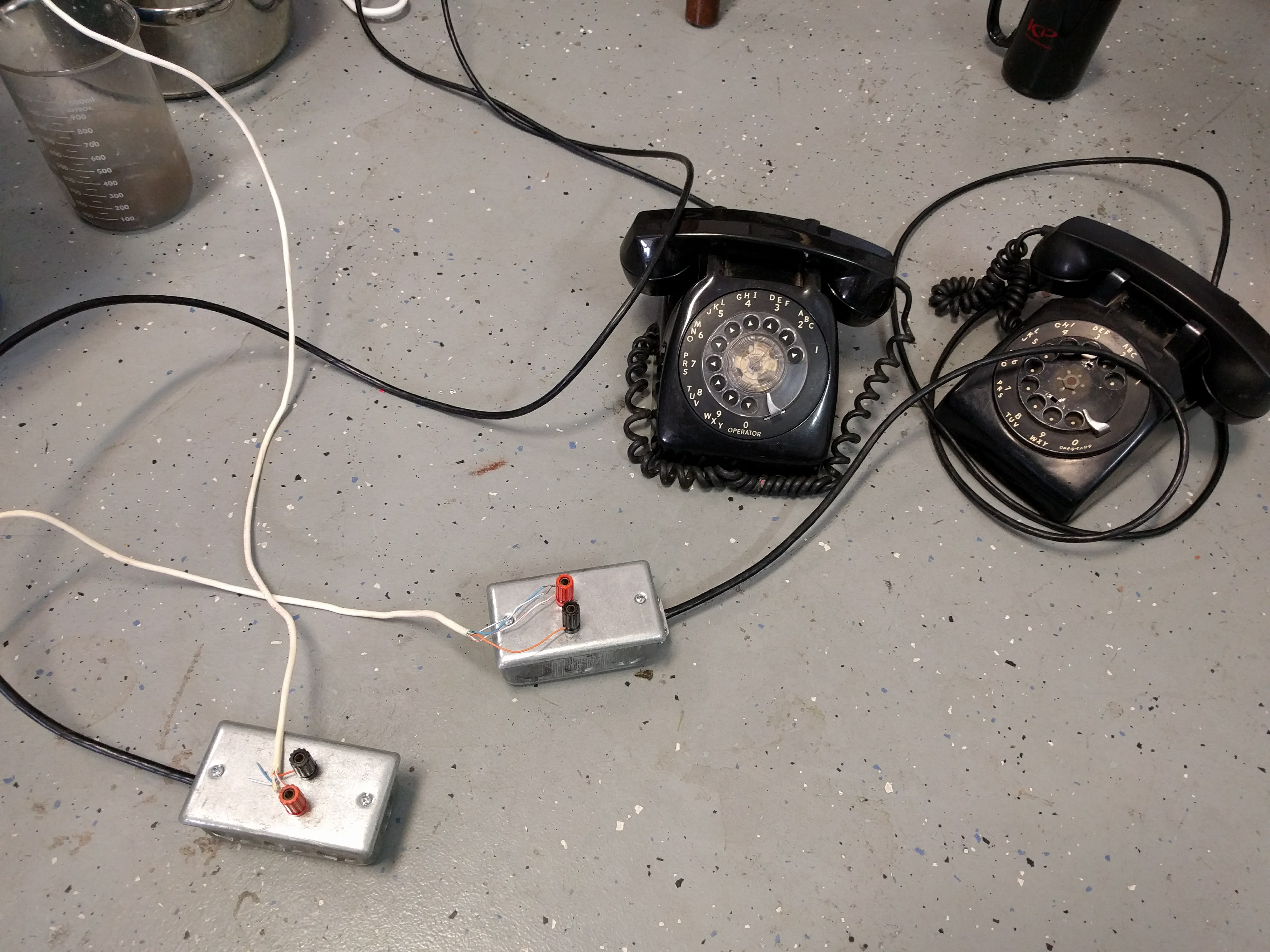Field Telephone
2014
I was working the summer at a Boy Scout camp in 2009 and wanted a way to communicate between two buildings across a large field. I had seen military field telephones before, but I did not want to spend the money to buy one. Instead, I rewired two old rotary dial phones to work as point to point field telephones.
Using hard wired telephones instead of radios is a little impractical most of the time, but they don’t need to be charged an they’re a neat thing to have. I set them up in college to connect my kitchen to my detached garage, and every engineer I had over wanted to play with them.

Modified Telephone
Ringing the Phones
Normal phones are rung with a 20 Hz 90V sine wave. In a traditional field telephone this is generated with a hand cranked magneto. My uncle gave me one pulled from a WWII field telephone when I was very young, but I would need another in order for both sides to be able to ring each other. The magneto was also an extra piece that would need to be mounted to something separate from the phone. The ringing voltage could be generated from battery power using a boost converter and a chopper circuit, but that would have required a larger battery as well as electronics knowledge that I didn’t have at the time.
Instead of using the original bells, I changed the circuit so that a low voltage DC buzzer was connected in its place. I used a buzzer that outputs a tone for about 1 second and then is silent for a second before outputting the tone again. That made it sound more like an actual phone, and it made it easier to hear from far away. These old rotary dial phones disconnect the bells from the line once the phone is taken off hook, so that didn’t require any rewiring. When the phone sees 9V on the line, it starts to ring and then stops ringing when it is taken off hook.
The buzzers not only make a sound that can be heard at the receiver, but they also add the same tone to the line so that the sending handset knows that the other end is ringing. This wasn’t an intentional feature, but it worked out that way because the power inputs to the cheap Chinese buzzers happen to not be very well filtered.

Inside Telephone 1
Powering the Phones
Since each phone needs to be able to supply voltage to the line when it rings the other side, each phone has its own battery. Taking advantage of the point to point screw terminal construction of the phones, I found the spot in the circuit where the hook switch connects the line to the hybrid transformer and placed a 9V battery in series there. When the phone is on hook, the battery is connected to an open circuit on the hook side so no current is drawn from the batteries during standby.
The internal circuitry in the phone roughly acts as a current source at least at these voltages. If you short the tip and ring of one of these modified phones while it is off hook, about 20mA will flow. As you increase the resistance between the tip and ring, the current remains constant until the voltage gets too high for the battery to maintain it. Ignoring the inductance of the lines, these phones should operate just fine over lines as long as 6 miles (the length of a 22 AWG loop that has 1k Ohm of resistance).
The phones should provide about 20 hours of talk time per battery. At around $2 per battery and considering that two phones are used at once, the operational cost is surprisingly low at around 0.3 cents per minute.

Inside Telephone 2
Interconnection
When I first built these phones, I relied on twisting the wires together to connect one phone to another one. If I got the polarity wrong, they didn’t work, so it was trial and error to hook them up if I didn’t remember which color went where. I ran the phones through 1000 ft. of Cat3 phone cable at the camp. I built three 30′ tall A-frame pioneering tripods to carry the line across the field high enough to stay out of everyone’s way. The line seemed to do fine under the strain without any additional support, but it was almost certainly exceeding the maximum pull force specified by the wire manufacturer.
I cleaned up the external wiring connection in 2015 since my younger brother was going to be working at the same camp and wanted to use the phones. I replaced the cords with durable direct burial cable and put metal electrical handy boxes on the ends. I took a bare face plates and drilled holes in it to accept banana jacks that I had salvaged from old equipment. This setup allows wire to be securely connected to the phones in the field and for the phones to be quickly tested using standard banana plug test cables.
In order to make the phones easier to set up, I used different colors for the banana jacks that correspond to positive and negative for the two phones. Wired like this, a user can be told to connect red to red and black to black instead of having to explain wiring them in parallel which becomes slightly more confusing when the actual wire being connected to is a different color than the banana jacks. If I had more than two of these phones, I would wire them all the same and connect them red to black and black to red, but since I only have two of them there isn’t a huge benefit to wiring them the same.

Both Telephones